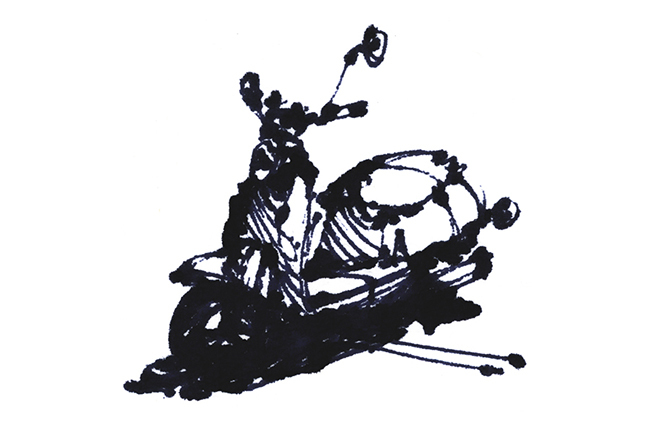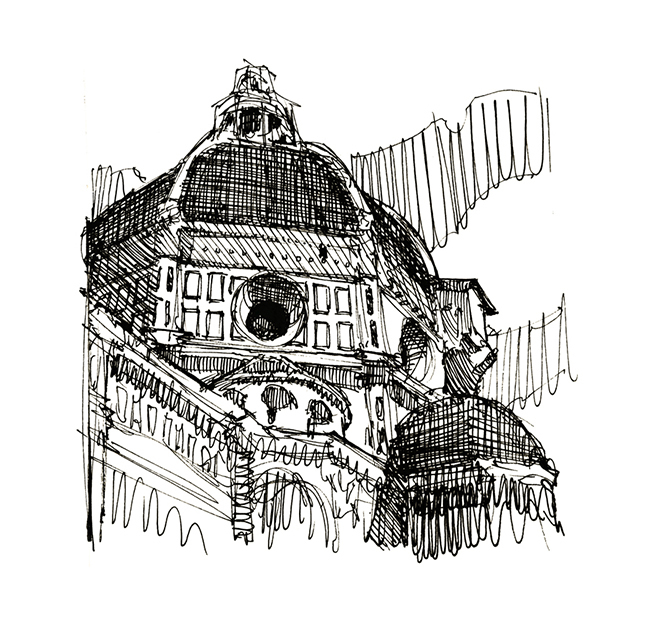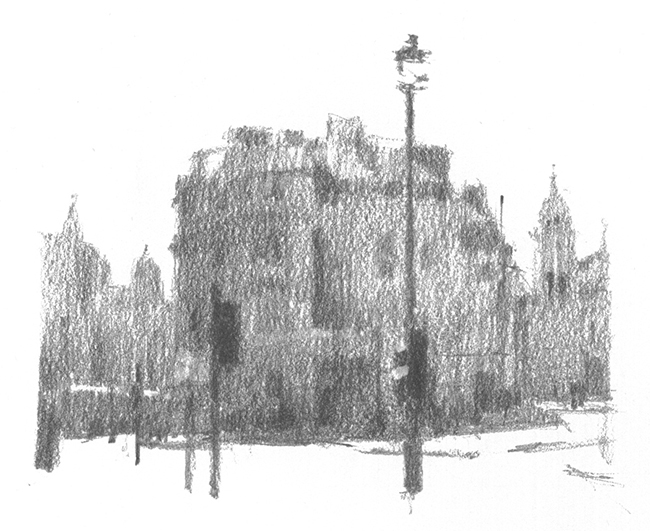“It is an intense, focused experience that you are really after. That is where the growth is, that is where the fun is, and that is where the reward is. The sketch then becomes a record of that in-depth experience.”
Richard Scott is a passionate champion of the sketch. He believes in the philosophy behind sketching, the process and the practice, the experience, and the resulting confidence gained by honing one’s sketching skills. In his book, Sketching from Square One… to Trafalgar Square, published by Sierra Madre Press, Scott provides a step-by-step process by which anyone, at any skill level can begin, improve, and refine his or her own sketching skills.
I recommend reading Sketching from Square One… to Trafalgar Square the first time through as if you were reading a novel. This is especially true if the reader is just beginning to learn to sketch. Scott’s expert, supportive, and generous prose is a reflection of his teaching style. In reading the lessons before beginning the actual work, readers will be exposed to his confidence-building techniques and a particular style that comes from many years of teaching the illustrative arts. The illustrations within the book, drawn by Scott, along with a few carefully chosen works by former students, provide a great deal of inspiration and instruction, making this an enjoyable page-turner as well.
Sketching from Square One to Trafalgar Square is organized around three main parts – within which are ten chapters. Part One, entitled Square One, provides the practitioner with “Ten Lessons to Better Drawing”. These lessons focus on developing an accurate sketch by measuring to achieve proportional accuracy, rendering alignments, angles and curves, and deciding in which sequence the lines and shapes will be laid down on paper.
Simplify
In Part Two, How To See, Scott uses the mnemonic device “S.E.E.” to demonstrate how we may begin to “see with the eyes of an artist”. The first of the three steps, Simplify, is a method used to investigate the act of seeing as it applies to choices and editing of subject matter, simplifying subjects into abstract shapes, and developing patterns out of what isobserved, and then simplified.
Emotional Response
The second step is titled Emotional Response. Here we look at one’s own motivation for sketching a particular subject. By asking yourself which features attracted you to this subject to begin with; such as composition, abstract shapes, etc., you begin to clarify the intent of your sketch, drawing only those features that are important to you and again editing out that which is not.
Examine & Compare
The final step of S.E.E. is Examine & Compare; Here Scott teaches us how to do just that, examine a single element within the drawing such as composition, edge, or tonal value, and then compare the relationship of this chosen element in the drawing to the variety of other elements. The intent being to “more accurately reproduce these (multiple) relationships in your sketchbook.”
Having laid out a philosophical groundwork for sketching and introducing us to many important concepts in Parts One and Two, in Part Three, How To Sketch, Scott now begins to walk us through the actual experience, the practice of sketching. Here, in my opinion, is one of the most vital lessons Richard Scott’s book has to offer.
“… improving your abilities to concentrate and see is the point of practice, not so much the development of drawing techniques or the making of pictures. It is an intense, focused experience that you are really after. That is where the growth is, that is where the fun is, and that is where the reward is. The sketch then becomes a record of that in-depth experience.”
S.K.E.T.C.H
In Part Three, Scott provides another acronym, S.K.E.T.C.H. (Selection, Keep it Accurate, Edges, Tonal Values, Contrast, Halt). This method is provided to help the reader remember the six steps involved in producing a satisfying sketch. Each letter also represents one chapter of Part Three. Chapter One Selection, discusses the defining, limiting, composing, and editing the chosen sketch subject. With many examples provided to illustrate the concepts, this chapter is a reassuring first step toward your ability to “draw less but express more”.
Keep it Accurate
In Chapter Two, Keep it Accurate, the author lays out some basic rules for creating an accurate sketch. These include the ideas touched upon in Part One, but here we delve into a finer-grained discussion regarding concepts such as “drawing what you see, not what you know”, “working from easier to more difficult”, and looking for visual clues for accurate proportion, alignment, and angles.
The sketching lessons continue to build upon one another through Edges, Tonal Values, and Contrast (Chapters 3,4, and 5) with the final chapter of Part Three being Halt. This of course is a tricky subject for even the most practiced of artists – “When to Stop Sketching”. Here the author’s approach is not so much from the practical standpoint of a highly detailed (i.e. finished) sketch, but from his more philosophical point of view. So I’ll leave this final lesson of Halt for Scott to impart, and for you the reader to absorb. Yet it is suffice to say that the resolution of a sketch returns us full circle to the initial dialogue concerning our expression and the experience itself.
Sketch by Richard E. Scott
The blurb on the back-cover states; “Richard E. Scott is an artist, architectural illustrator, and licensed landscape architect.” This of course is true. Yet he is also more than this. Richard E. Scott is a teacher; that noble profession in which one gives generously of their time and talents for the learning benefit of others, and the evidence of this is all within the pages of Sketching from Square One… to Trafalgar Square. As stated above, I believe this is a great book for the current sketch practitioners among us. Yet it also doubles as a valuable companion and tour guide for those about to bravely embark upon their first sketching journey.
I highly recommend Richard Scott’s book, Sketching from Square One… to Trafalgar Square to those teachers and professors of architecture, landscape architecture, and the fine arts who are in search of an effective and enjoyable way in which to encourage students to pick up a pencil and draw. This book is motivation and encouragement for all of us to experience the many rewards that a routine sketching practice brings.
Sketch by Richard E. Scott
Richard E. Scott is a licensed landscape architect, architectural illustrator, watercolorist, and teacher. You can learn about his graphics workshops at www.graphicsteacher.com. To contact Richard about conducting a workshop at your office or school, or to inquire about hiring Richard to produce sketches or renderings for your office, he can be reached at richard@graphicsteacher.com.
An in depth interview with Richard from 2014 can be found here. https://land8.com/profiles/blogs/interview-with-landscape-architect-richard-e-scott/
Buy the book on Amazon
All images courtesy Richard E. Scott.
Published in Blog















CJ Davis
this is a must have for any artist or designer.
Francisco J. Serrano
Excellent Andrew, how to get it?
Mitch Howard
Hello Francisco – Here is the link to Richard Scott’s personal website: http://www.graphicsteacher.com
Or you can purchase from Amazon at Sketching from Square One… to Trafalgar Square .
I’m glad you enjoyed the review!
Andrew Spiering
Hi Francisco – I added a links in the post to Amazon. You can also follow the link Mitch provided.
Thanks!